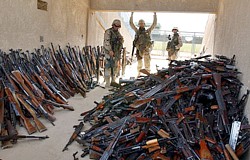Analysis: Black-Market Weapon Prices Surge in Iraq Chaos
 SULAIMANIYA, Iraq, Dec. 8 — The Kurdish security contractor placed the black plastic box on the table. Inside was a new Glock 19, one of the 9-millimeter pistols that the United States issued by the tens of thousands to the Iraqi Army and police.
SULAIMANIYA, Iraq, Dec. 8 — The Kurdish security contractor placed the black plastic box on the table. Inside was a new Glock 19, one of the 9-millimeter pistols that the United States issued by the tens of thousands to the Iraqi Army and police.This pistol was no longer in the custody of the Iraqi Army or police. It had been stolen or sold, and it found its way to an open-air grocery stand that does a lively black-market business in police and infantry arms. The contractor bought it there.
He displayed other purchases, including a short-barreled Kalashnikov assault rifle with a collapsible stock that makes it easy to conceal under a coat or fire from a car. “I bought this for $450 last year,” he said of the rifle. “Now it costs $650. The prices keep going up.”
The market for this American-issued pistol and the ubiquitous assault rifle illustrated how fear, mismanagement and malfeasance are shaping the small-arms market in Iraq.
Weapon prices are soaring along with an expanding sectarian war, as more buyers push prices several times higher than those that existed at the time of the American-led invasion nearly four years ago. Rising prices, in turn, have encouraged an insidious form of Iraqi corruption — the migration of army and police weapons from Iraqi state armories to black-market sales.
All manner of infantry arms, from rocket-propelled grenade launchers to weathered and dented Kalashnikovs, have circulated within Iraq for decades.
But three types of American-issued weapons are now readily visible in shops and bazaars here as well: Glock and Walther 9-millimeter pistols, and pristine, unused Kalashnikovs from post-Soviet Eastern European countries. These are three of the principal types of the 370,000 weapons purchased by the United States for Iraq’s security forces, a program that was criticized by a special inspector general this fall for, among other things, failing to properly account for the arms.
Read the rest at the NY Times

<< Home